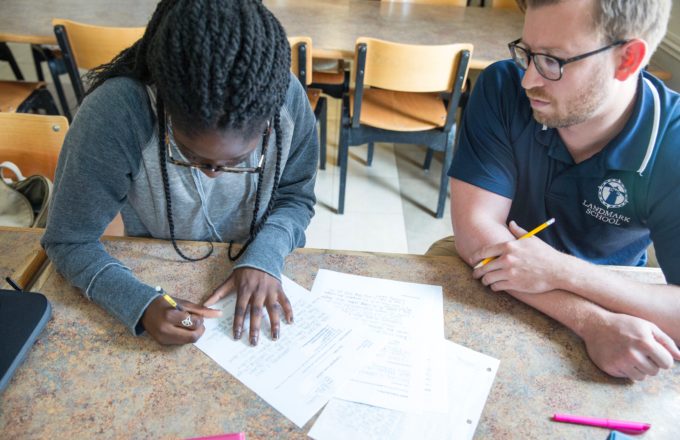Metacognition and Written Expression
The thinking phase of writing refers to a student’s opportunity to think about what they know about a topic and put that understanding in writing. This phase is much more complex than it appears on the surface, as successful writing incorporates many academic and metacognitive skills. When students are asked to write, it is assumed that they have basic reading and spelling ability and that they are able to understand what they have read. As the pace, volume, and complexity of schoolwork increases, students are expected to analyze texts and develop arguments in their writing. Inherent in all of these tasks are strong study skills or a student’s ability to manage the time, materials, and information involved in any writing task.
When asked to transfer their thoughts into writing, there are many places for students to lose their way or get confused. Students can become overwhelmed when they embark on writing assignments without enough background knowledge, and the subsequent downstream consequences are often writing that contains incomplete ideas or lack of clarity. Additionally, when students are overloaded by the expectations of a writing assignment, they can have difficulty getting started. A student may also be unclear about what they are tasked to do. Maybe they are confused about what it means to “analyze” or don’t understand how to structure a compare and contrast paragraph. When asking students of any age to write, consider the four Cs as a way to boost a student’s ability to think about the thinking phase of writing.
1. Collect Sources:
The specific objectives of a writing assignment should be considered when thinking about the source material for students. Is the objective of the task to demonstrate the ability to organize information on a variety of sources? Is it to simply demonstrate what they know about a topic? Or is the expectation for students to analyze important passages under an established theme? Teachers need to consider the age and ability of their students before assigning sources and/or outlining how they expect students to gather them.
Instructional Strategies:
- A clear purpose for reading to help focus understanding
- Reminders of the source(s) introduced in class
- Instruction on how to use the library and peer-reviewed electronic databases
- Encouragement for students use to the librarian to assist with research
- Identification of valid and vetted sources
- Use of alternative search engines to Google
2. Comprehend Arguments and Points of View:
No matter the age of a student, to comprehend the author’s purpose for writing, students need to understand that different types of sources are structured differently. For example, a textbook entry has a different organizational structure and purpose than a chapter in a novel or a newspaper article. Explaining these differences in text structure helps students comprehend what they read and provides a model for their own writing. Strategies for understanding a nineteenth-century editorial cartoon about the Civil War differ from those for comprehending the personal writings of a soldier or a transcribed interview from that time. Students also need to learn that different sources reveal their points and biases differently. This is particularly important with primary source material and non-expository forms of opinion. Much of this skill set is targeted at older students; however, it can be beneficial for younger students to understand the perspective of an author and how that perspective may or may not contribute to the topic of their writing.
Instructional Strategies:
- Instruction on the different types of sources and their function and organization (textbook, articles, novel, blog, first-person account etc.)
- Instruction on how to use guided notes and how to help organize main ideas
- Instruction on how to locate main ideas and details.
- Instruction on author bias and perspective
3. Critically Think
Writing at all levels frequently asks students to think critically about what they have read, meaning that they are asked to take a perspective and defend it with evidence and examples or to defend how and why something has occurred. This task of critically examining what was read can be as simple as stating why a certain toy is a favorite, to analyzing the questionable moral actions of a character, to defending why schools should refrain from assigning homework. Regardless of the complexity of the topic, students must have a clear understanding of what it means to analyze and what constitutes evidence and example, as without this understanding students will struggle to formulate a response.
Instructional Strategies:
- Instruction on how to properly summarize and paraphrase or directly quote information
- Discussion of the how and why of given topics and record class notes and ideas
- Instruction on specific composition vocabulary such as analyze, compare, define, defend, and example
4. Craft a Response
It is equally as important to teach students the study skills to be able to organize and categorize the information that they encounter as source material for a writing assignment as it is to give them the structure and support to organize their own thoughts about what they have read. These organizational structures should be taught explicitly. No matter the age of the student, it is important to carefully review the expectations, from the importance of complete sentences to the structure of an argumentative research paper.
Instructional Strategies:
- Instruction on the structure of different types of written responses (compare and contrast, enumerative, expository, narrative, analysis, persuasive)
- Instruction on how to use templates for the various styles and formats of writing
- Instruction on how to properly summarize and paraphrase or directly quote information
References
Excerpted from: Teaching Independent Minds: A Landmark School Teaching Guide (out of print) by Patricia W. Newhall © 2008
